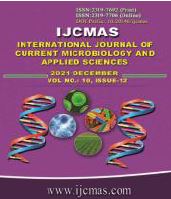


 National Academy of Agricultural Sciences (NAAS)
National Academy of Agricultural Sciences (NAAS)

|
PRINT ISSN : 2319-7692
Online ISSN : 2319-7706 Issues : 12 per year Publisher : Excellent Publishers Email : editorijcmas@gmail.com / submit@ijcmas.com Editor-in-chief: Dr.M.Prakash Index Copernicus ICV 2018: 95.39 NAAS RATING 2020: 5.38 |
A field experiment was carried out in El Guabo, Ecuador, to study how sucker selection affect root content, nematode numbers, and yield variables on banana (Musa AAA cv. Valery) plants. The two treatments evaluated were sword sucker selection at plant flowering and early sword sucker selection of 60 cm height on un-shooting plants. The two treatments were laid out in RCD with ten replicates and in each replicated, 10 of each sucker were evaluated across five ratoon crop cycles. With few exceptions, no differences were found in root contents between the two types of sword sucker selected. No differences in the number of Pratylenchus spp. (P> 0.0911), Meloidogyne spp.(P> 0.1011), Helicotylenches spp., (P> 0.1189), Radopholus similis(P> 0.2657), and total nematodes (P> 0.0557) were found in none of the ratoons between the two types of suckers selected. The number of total nematodes varied across the five ratoon crop cycles between 6021 and 22327 per 100 g of roots by sucker. In none of the yield variables (bunch weight P> 0.1528, ratio P> 0.1527, rationing P> 0.1261, and number of boxes per hectare by year P> 0.1447) differences were found between the selected suckers at the parent plant and the subsequent four ratoon crop cycles. Across the five harvests, the number of boxes oscillated between 2971 and 4072per hectare per year. Although, no differences in yield were found, in the last three ratoon crop cycles consistently more than 100 (106 to 133) boxes per hectare per year were got when sucker selection was done on un-shooting plants. Considering the actual market price of a box of 18.14 kg of bananas of US $6.25, the additional net income from the increase in yield, deducted the cost of labour of $0.75 of packing for each additional box would varies between 580 to 732 US$ per hectare per year.
 |
 |
 |
 |
 |